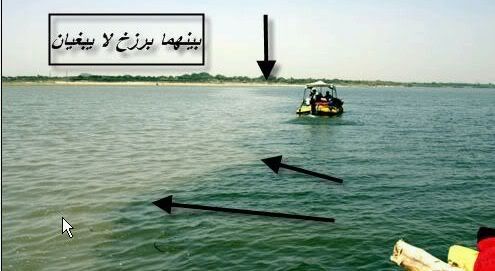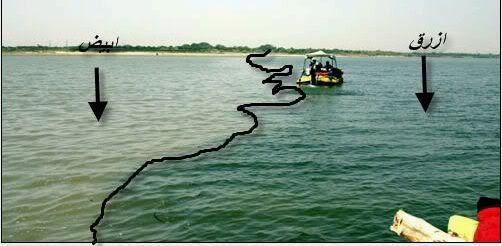:salam2:
About similar phenomena happened to Strait of Gibraltar:
1.
http://www.lpi.usra.edu/publications/slidesets/humanimprints/slide_15.html
"High rates of evaporation in the relatively shallow Mediterranean basin cause the water to become saltier, and thereby denser, than the relatively fresh Atlantic water. As Atlantic water is forced through the narrow strait it accelerates and interacts with Mediterranean water. Internal waves (particularly those formed at depths of 60–80 meters) develop where these two different water masses interact. Large, tidally induced pulses of Atlantic water entering the Mediterranean can be seen here as a series of crescents emanating from the strait. These crescents result from interactions of these different water masses at depth."
2.
http://pulson.seos.uvic.ca/gibralt.html
"Progress in Oceanography 1988,21 (1), 1-105
The Flow of Atlantic Water Through the Strait of Gibraltar
David M. Farmer1 & Laurence Armi2
The Flow of Mediterranean Water Through the Strait of Gibraltar
Laurence Armi2 & David Farmer1
Abstract:
We describe and analyze observations of the water exchange through the Strait of Gibraltar. The primary observations were taken in April 1986 and included data from moored recording instruments at four locations in the strait, together with an intensive survey by ship. These measurements included extensive CTD profiling, acoustic Doppler current profiling, numerous profiles from expendable instruments, and imaging using a high-frequency echo sounder.
The analysis focuses on the internal hydraulics of the Strait and in particular the presence of hydraulic controls and their influence on the exchange. Our observations during April 1986 show that the maximal exchange condition, in which a subcritical flow is bounded by supercritical flow at both ends of the Strait, did occur, although with various subtleties not explicitly incorporated in our previous theoretical developments.
The Atlantic water, moving east along the surface, encounters a control at Tarifa Narrows in the eastern part of the Strait. The Mediterranean water passes through controls both at Camarinal Sill and at Spartel Sill, further west. At our westernmost mooring at Spartel, the outflowing Mediterranean water is continuously supercritical, with little tidal variability. The control at Camarinal Sill is periodically lost due to tidal action and reappears on a reverse flow during a falling spring tide. Tangier Basin, bounded by Camarinal and Spartel Sills, acts as an internal reservoir for the outflowing Mediterranean water, the
interface rising and falling through each tidal cycle. During spring tides, the Tangier Basin interface rises high enough to flood the control at Camarinal Sill and produces a reverse flow of the lower layer. When control is lost at Camarinal Sill a travelling bore is released. This bore may modify the location of the control acting on the surface layer in Tarifa Narrows. The Atlantic water enters the Alboran Sea as a jet which may have a well-defined northern boundary where it separates from the European coast; this boundary may be identified by the presence of a slick. Although the internal jump west of Camarinal Sill is almost certainly an area of intense mixing, frictional effects do not appear to be dominant in the subcritical portion of the flow."







